Corporate Responsibility and Sustainability in the Clothing Industry
VerifiedAdded on 2023/01/09
|14
|3984
|44
AI Summary
This report discusses the key challenges and best practices in corporate responsibility and sustainability in the clothing industry. It explores ethical and moral issues, provides recommendations for businesses, and highlights the importance of CSR activities in improving brand image and customer satisfaction.
Contribute Materials
Your contribution can guide someone’s learning journey. Share your
documents today.

Business Ethics Responsibility
and Sustainability
and Sustainability
Secure Best Marks with AI Grader
Need help grading? Try our AI Grader for instant feedback on your assignments.
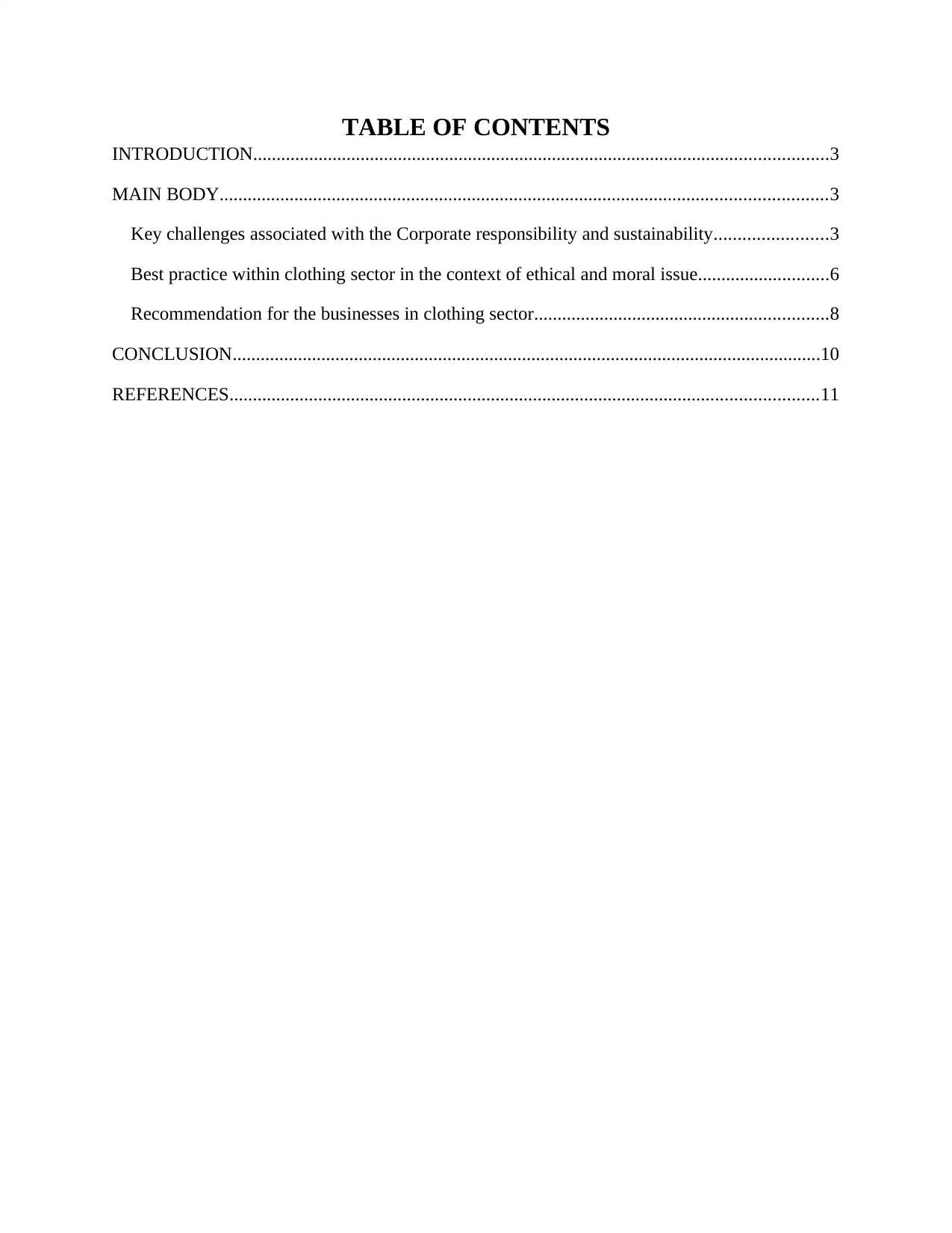
TABLE OF CONTENTS
INTRODUCTION...........................................................................................................................3
MAIN BODY..................................................................................................................................3
Key challenges associated with the Corporate responsibility and sustainability........................3
Best practice within clothing sector in the context of ethical and moral issue............................6
Recommendation for the businesses in clothing sector...............................................................8
CONCLUSION..............................................................................................................................10
REFERENCES..............................................................................................................................11
INTRODUCTION...........................................................................................................................3
MAIN BODY..................................................................................................................................3
Key challenges associated with the Corporate responsibility and sustainability........................3
Best practice within clothing sector in the context of ethical and moral issue............................6
Recommendation for the businesses in clothing sector...............................................................8
CONCLUSION..............................................................................................................................10
REFERENCES..............................................................................................................................11
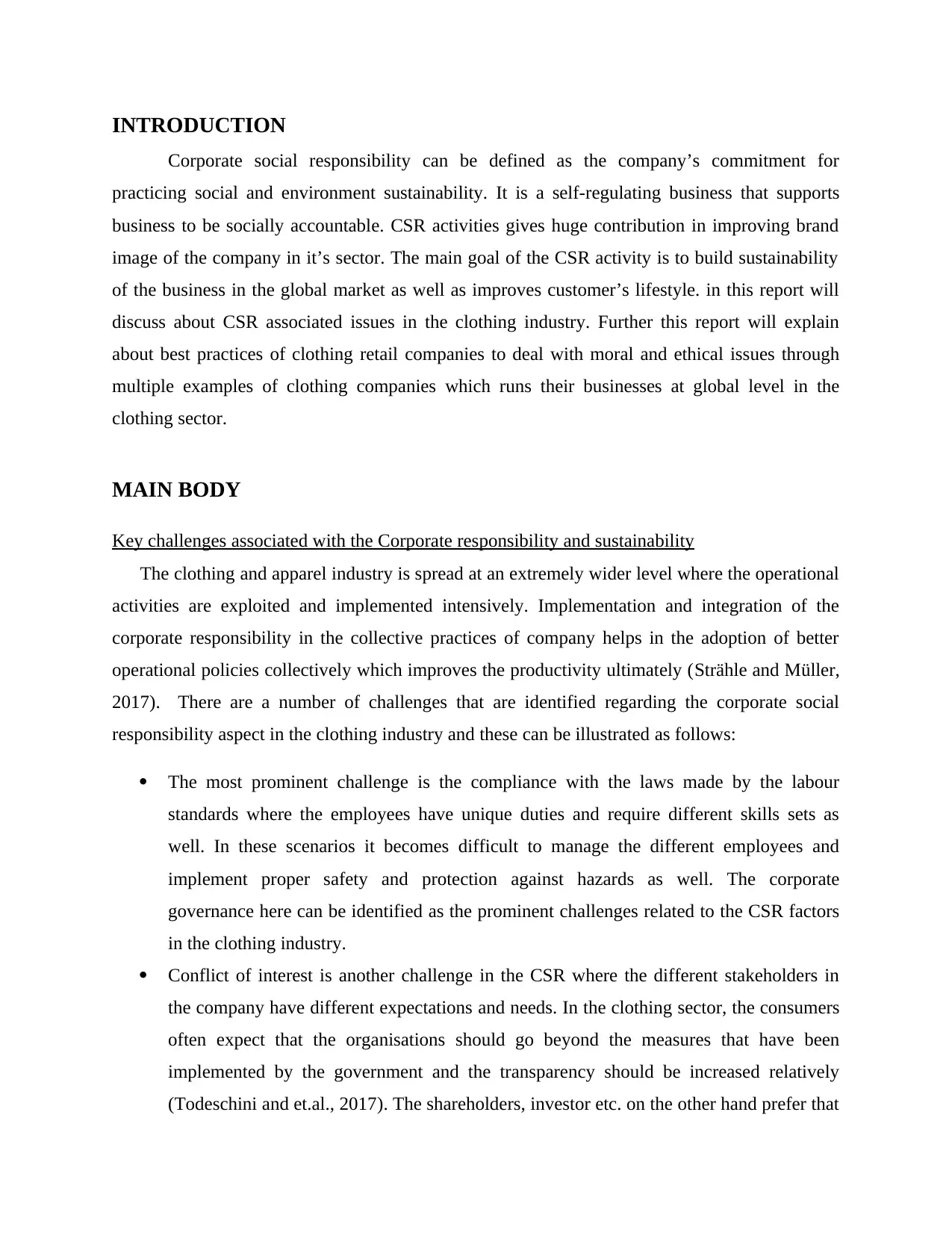
INTRODUCTION
Corporate social responsibility can be defined as the company’s commitment for
practicing social and environment sustainability. It is a self-regulating business that supports
business to be socially accountable. CSR activities gives huge contribution in improving brand
image of the company in it’s sector. The main goal of the CSR activity is to build sustainability
of the business in the global market as well as improves customer’s lifestyle. in this report will
discuss about CSR associated issues in the clothing industry. Further this report will explain
about best practices of clothing retail companies to deal with moral and ethical issues through
multiple examples of clothing companies which runs their businesses at global level in the
clothing sector.
MAIN BODY
Key challenges associated with the Corporate responsibility and sustainability
The clothing and apparel industry is spread at an extremely wider level where the operational
activities are exploited and implemented intensively. Implementation and integration of the
corporate responsibility in the collective practices of company helps in the adoption of better
operational policies collectively which improves the productivity ultimately (Strähle and Müller,
2017). There are a number of challenges that are identified regarding the corporate social
responsibility aspect in the clothing industry and these can be illustrated as follows:
The most prominent challenge is the compliance with the laws made by the labour
standards where the employees have unique duties and require different skills sets as
well. In these scenarios it becomes difficult to manage the different employees and
implement proper safety and protection against hazards as well. The corporate
governance here can be identified as the prominent challenges related to the CSR factors
in the clothing industry.
Conflict of interest is another challenge in the CSR where the different stakeholders in
the company have different expectations and needs. In the clothing sector, the consumers
often expect that the organisations should go beyond the measures that have been
implemented by the government and the transparency should be increased relatively
(Todeschini and et.al., 2017). The shareholders, investor etc. on the other hand prefer that
Corporate social responsibility can be defined as the company’s commitment for
practicing social and environment sustainability. It is a self-regulating business that supports
business to be socially accountable. CSR activities gives huge contribution in improving brand
image of the company in it’s sector. The main goal of the CSR activity is to build sustainability
of the business in the global market as well as improves customer’s lifestyle. in this report will
discuss about CSR associated issues in the clothing industry. Further this report will explain
about best practices of clothing retail companies to deal with moral and ethical issues through
multiple examples of clothing companies which runs their businesses at global level in the
clothing sector.
MAIN BODY
Key challenges associated with the Corporate responsibility and sustainability
The clothing and apparel industry is spread at an extremely wider level where the operational
activities are exploited and implemented intensively. Implementation and integration of the
corporate responsibility in the collective practices of company helps in the adoption of better
operational policies collectively which improves the productivity ultimately (Strähle and Müller,
2017). There are a number of challenges that are identified regarding the corporate social
responsibility aspect in the clothing industry and these can be illustrated as follows:
The most prominent challenge is the compliance with the laws made by the labour
standards where the employees have unique duties and require different skills sets as
well. In these scenarios it becomes difficult to manage the different employees and
implement proper safety and protection against hazards as well. The corporate
governance here can be identified as the prominent challenges related to the CSR factors
in the clothing industry.
Conflict of interest is another challenge in the CSR where the different stakeholders in
the company have different expectations and needs. In the clothing sector, the consumers
often expect that the organisations should go beyond the measures that have been
implemented by the government and the transparency should be increased relatively
(Todeschini and et.al., 2017). The shareholders, investor etc. on the other hand prefer that

there should be a certain level of privacy or secrecy implemented by the management of
the company. This often creates a challenge before the management authority of the
company.
Often, due to intensive competition that exists in the clothing industry, brand tends to cut
down on the operational costs that are incurred by setting up manufacturing outlets in
those areas where labour is cheaply available and production is cheaper (Boström and
Micheletti, 2016). This however reduces the chances of employment and revenue
generation for the country in which it is operating mainly. Additionally, the profit
maximisation objectives also make it difficult for the companies to fulfil the CSR
objectives of the company.
There are a variety of quality standards that have been set up by the government and
legislations which the companies operating in this clothing industry are required to follow
such as international standards compliance like ISO 9001, ISO 14001 etc. and the
supplier’s code of conduct has also been developed which can help in implementation of
better practices (Garcia-Torres, Rey-Garcia and Albareda-Vivo, 2017). The concept of
conducting social audit also affects the overall operation of the CSR practices in
organisation.
The sourcing decisions that are being made by the companies also affect the overall CSR
compliance of the organisations where the consumers have now become increasingly
concerned regarding the different sources from which the brands are collecting their raw
materials. For instance, evaluation that no child labour is being promoted in those
countries, or the discriminations based on gender, colour etc. is not being implemented.
Overall it can be concluded that the challenges that the clothing industries face in the
implementation of the CSR activities and the different aspects that are associated with it are
diverse in today’s era when the different associated aspects have become so diverse.
Apart from corporate responsibility, the concept of sustainability has also gained
prominence over time. It has now become necessary to comply with different aspects associated
with sustainability as well so that the overall fulfilment of job roles is more comprehensive. The
different challenges that can arise in the sustainability compliance by the clothing industry are as
follows:
the company. This often creates a challenge before the management authority of the
company.
Often, due to intensive competition that exists in the clothing industry, brand tends to cut
down on the operational costs that are incurred by setting up manufacturing outlets in
those areas where labour is cheaply available and production is cheaper (Boström and
Micheletti, 2016). This however reduces the chances of employment and revenue
generation for the country in which it is operating mainly. Additionally, the profit
maximisation objectives also make it difficult for the companies to fulfil the CSR
objectives of the company.
There are a variety of quality standards that have been set up by the government and
legislations which the companies operating in this clothing industry are required to follow
such as international standards compliance like ISO 9001, ISO 14001 etc. and the
supplier’s code of conduct has also been developed which can help in implementation of
better practices (Garcia-Torres, Rey-Garcia and Albareda-Vivo, 2017). The concept of
conducting social audit also affects the overall operation of the CSR practices in
organisation.
The sourcing decisions that are being made by the companies also affect the overall CSR
compliance of the organisations where the consumers have now become increasingly
concerned regarding the different sources from which the brands are collecting their raw
materials. For instance, evaluation that no child labour is being promoted in those
countries, or the discriminations based on gender, colour etc. is not being implemented.
Overall it can be concluded that the challenges that the clothing industries face in the
implementation of the CSR activities and the different aspects that are associated with it are
diverse in today’s era when the different associated aspects have become so diverse.
Apart from corporate responsibility, the concept of sustainability has also gained
prominence over time. It has now become necessary to comply with different aspects associated
with sustainability as well so that the overall fulfilment of job roles is more comprehensive. The
different challenges that can arise in the sustainability compliance by the clothing industry are as
follows:
Secure Best Marks with AI Grader
Need help grading? Try our AI Grader for instant feedback on your assignments.
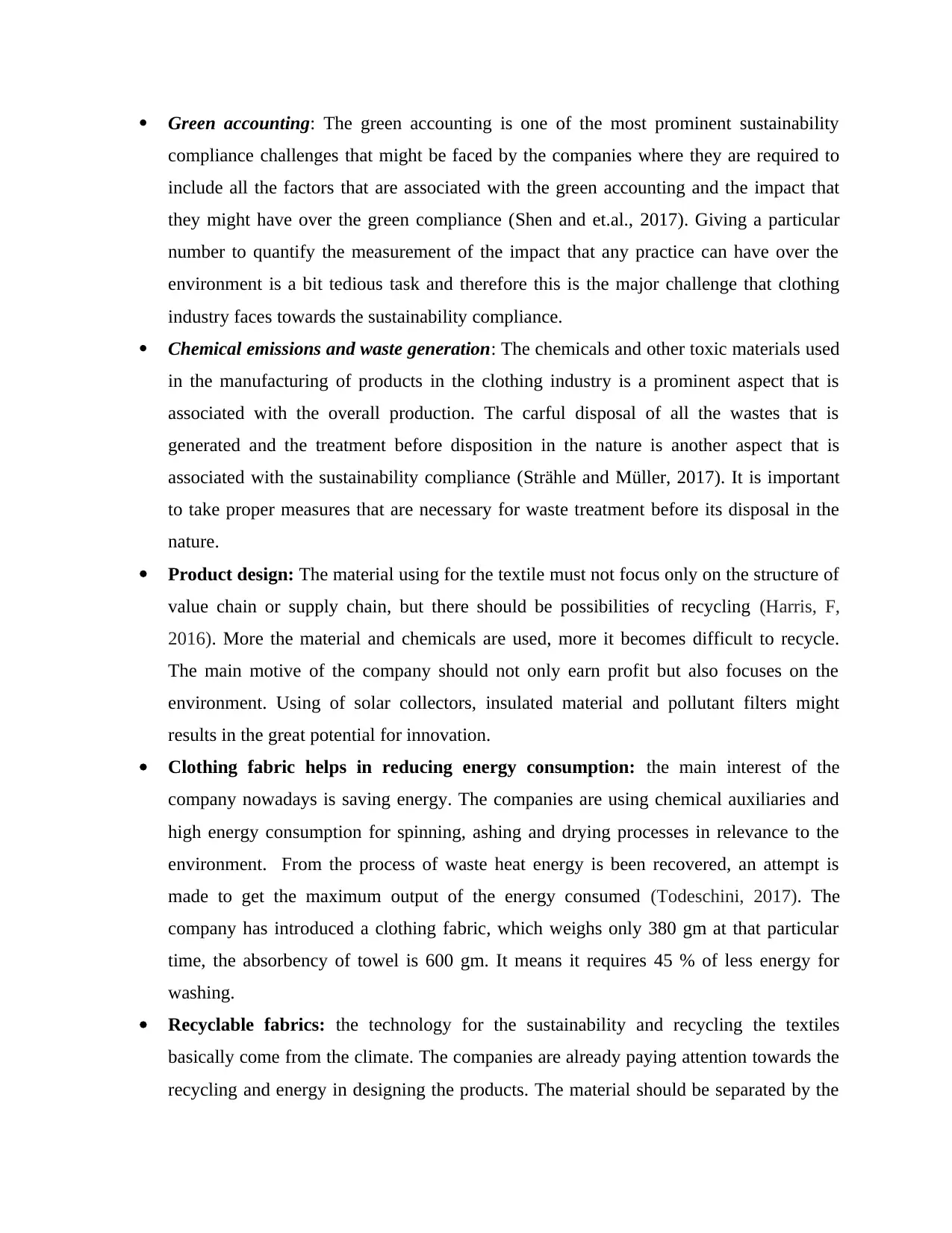
Green accounting: The green accounting is one of the most prominent sustainability
compliance challenges that might be faced by the companies where they are required to
include all the factors that are associated with the green accounting and the impact that
they might have over the green compliance (Shen and et.al., 2017). Giving a particular
number to quantify the measurement of the impact that any practice can have over the
environment is a bit tedious task and therefore this is the major challenge that clothing
industry faces towards the sustainability compliance.
Chemical emissions and waste generation: The chemicals and other toxic materials used
in the manufacturing of products in the clothing industry is a prominent aspect that is
associated with the overall production. The carful disposal of all the wastes that is
generated and the treatment before disposition in the nature is another aspect that is
associated with the sustainability compliance (Strähle and Müller, 2017). It is important
to take proper measures that are necessary for waste treatment before its disposal in the
nature.
Product design: The material using for the textile must not focus only on the structure of
value chain or supply chain, but there should be possibilities of recycling (Harris, F,
2016). More the material and chemicals are used, more it becomes difficult to recycle.
The main motive of the company should not only earn profit but also focuses on the
environment. Using of solar collectors, insulated material and pollutant filters might
results in the great potential for innovation.
Clothing fabric helps in reducing energy consumption: the main interest of the
company nowadays is saving energy. The companies are using chemical auxiliaries and
high energy consumption for spinning, ashing and drying processes in relevance to the
environment. From the process of waste heat energy is been recovered, an attempt is
made to get the maximum output of the energy consumed (Todeschini, 2017). The
company has introduced a clothing fabric, which weighs only 380 gm at that particular
time, the absorbency of towel is 600 gm. It means it requires 45 % of less energy for
washing.
Recyclable fabrics: the technology for the sustainability and recycling the textiles
basically come from the climate. The companies are already paying attention towards the
recycling and energy in designing the products. The material should be separated by the
compliance challenges that might be faced by the companies where they are required to
include all the factors that are associated with the green accounting and the impact that
they might have over the green compliance (Shen and et.al., 2017). Giving a particular
number to quantify the measurement of the impact that any practice can have over the
environment is a bit tedious task and therefore this is the major challenge that clothing
industry faces towards the sustainability compliance.
Chemical emissions and waste generation: The chemicals and other toxic materials used
in the manufacturing of products in the clothing industry is a prominent aspect that is
associated with the overall production. The carful disposal of all the wastes that is
generated and the treatment before disposition in the nature is another aspect that is
associated with the sustainability compliance (Strähle and Müller, 2017). It is important
to take proper measures that are necessary for waste treatment before its disposal in the
nature.
Product design: The material using for the textile must not focus only on the structure of
value chain or supply chain, but there should be possibilities of recycling (Harris, F,
2016). More the material and chemicals are used, more it becomes difficult to recycle.
The main motive of the company should not only earn profit but also focuses on the
environment. Using of solar collectors, insulated material and pollutant filters might
results in the great potential for innovation.
Clothing fabric helps in reducing energy consumption: the main interest of the
company nowadays is saving energy. The companies are using chemical auxiliaries and
high energy consumption for spinning, ashing and drying processes in relevance to the
environment. From the process of waste heat energy is been recovered, an attempt is
made to get the maximum output of the energy consumed (Todeschini, 2017). The
company has introduced a clothing fabric, which weighs only 380 gm at that particular
time, the absorbency of towel is 600 gm. It means it requires 45 % of less energy for
washing.
Recyclable fabrics: the technology for the sustainability and recycling the textiles
basically come from the climate. The companies are already paying attention towards the
recycling and energy in designing the products. The material should be separated by the
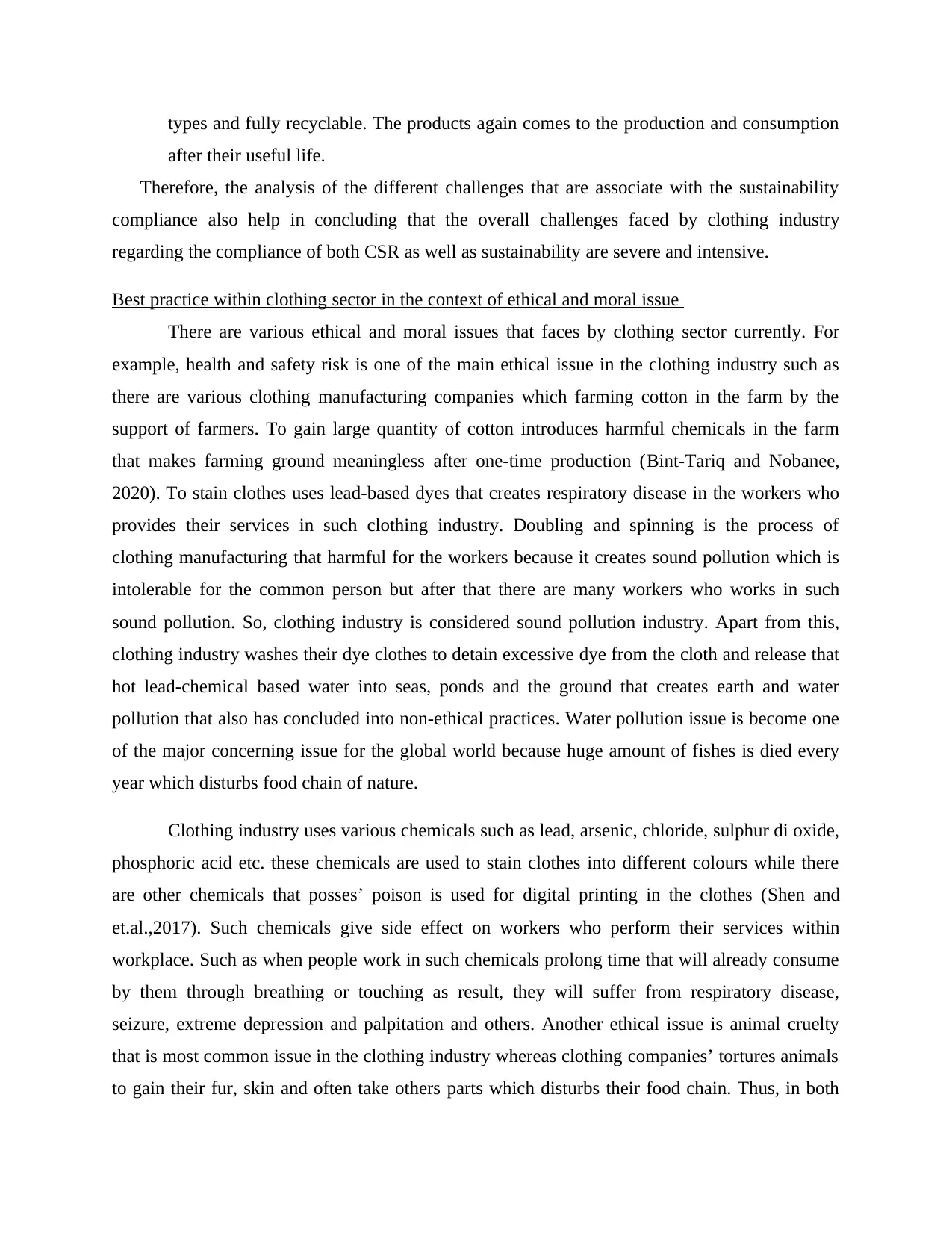
types and fully recyclable. The products again comes to the production and consumption
after their useful life.
Therefore, the analysis of the different challenges that are associate with the sustainability
compliance also help in concluding that the overall challenges faced by clothing industry
regarding the compliance of both CSR as well as sustainability are severe and intensive.
Best practice within clothing sector in the context of ethical and moral issue
There are various ethical and moral issues that faces by clothing sector currently. For
example, health and safety risk is one of the main ethical issue in the clothing industry such as
there are various clothing manufacturing companies which farming cotton in the farm by the
support of farmers. To gain large quantity of cotton introduces harmful chemicals in the farm
that makes farming ground meaningless after one-time production (Bint-Tariq and Nobanee,
2020). To stain clothes uses lead-based dyes that creates respiratory disease in the workers who
provides their services in such clothing industry. Doubling and spinning is the process of
clothing manufacturing that harmful for the workers because it creates sound pollution which is
intolerable for the common person but after that there are many workers who works in such
sound pollution. So, clothing industry is considered sound pollution industry. Apart from this,
clothing industry washes their dye clothes to detain excessive dye from the cloth and release that
hot lead-chemical based water into seas, ponds and the ground that creates earth and water
pollution that also has concluded into non-ethical practices. Water pollution issue is become one
of the major concerning issue for the global world because huge amount of fishes is died every
year which disturbs food chain of nature.
Clothing industry uses various chemicals such as lead, arsenic, chloride, sulphur di oxide,
phosphoric acid etc. these chemicals are used to stain clothes into different colours while there
are other chemicals that posses’ poison is used for digital printing in the clothes (Shen and
et.al.,2017). Such chemicals give side effect on workers who perform their services within
workplace. Such as when people work in such chemicals prolong time that will already consume
by them through breathing or touching as result, they will suffer from respiratory disease,
seizure, extreme depression and palpitation and others. Another ethical issue is animal cruelty
that is most common issue in the clothing industry whereas clothing companies’ tortures animals
to gain their fur, skin and often take others parts which disturbs their food chain. Thus, in both
after their useful life.
Therefore, the analysis of the different challenges that are associate with the sustainability
compliance also help in concluding that the overall challenges faced by clothing industry
regarding the compliance of both CSR as well as sustainability are severe and intensive.
Best practice within clothing sector in the context of ethical and moral issue
There are various ethical and moral issues that faces by clothing sector currently. For
example, health and safety risk is one of the main ethical issue in the clothing industry such as
there are various clothing manufacturing companies which farming cotton in the farm by the
support of farmers. To gain large quantity of cotton introduces harmful chemicals in the farm
that makes farming ground meaningless after one-time production (Bint-Tariq and Nobanee,
2020). To stain clothes uses lead-based dyes that creates respiratory disease in the workers who
provides their services in such clothing industry. Doubling and spinning is the process of
clothing manufacturing that harmful for the workers because it creates sound pollution which is
intolerable for the common person but after that there are many workers who works in such
sound pollution. So, clothing industry is considered sound pollution industry. Apart from this,
clothing industry washes their dye clothes to detain excessive dye from the cloth and release that
hot lead-chemical based water into seas, ponds and the ground that creates earth and water
pollution that also has concluded into non-ethical practices. Water pollution issue is become one
of the major concerning issue for the global world because huge amount of fishes is died every
year which disturbs food chain of nature.
Clothing industry uses various chemicals such as lead, arsenic, chloride, sulphur di oxide,
phosphoric acid etc. these chemicals are used to stain clothes into different colours while there
are other chemicals that posses’ poison is used for digital printing in the clothes (Shen and
et.al.,2017). Such chemicals give side effect on workers who perform their services within
workplace. Such as when people work in such chemicals prolong time that will already consume
by them through breathing or touching as result, they will suffer from respiratory disease,
seizure, extreme depression and palpitation and others. Another ethical issue is animal cruelty
that is most common issue in the clothing industry whereas clothing companies’ tortures animals
to gain their fur, skin and often take others parts which disturbs their food chain. Thus, in both
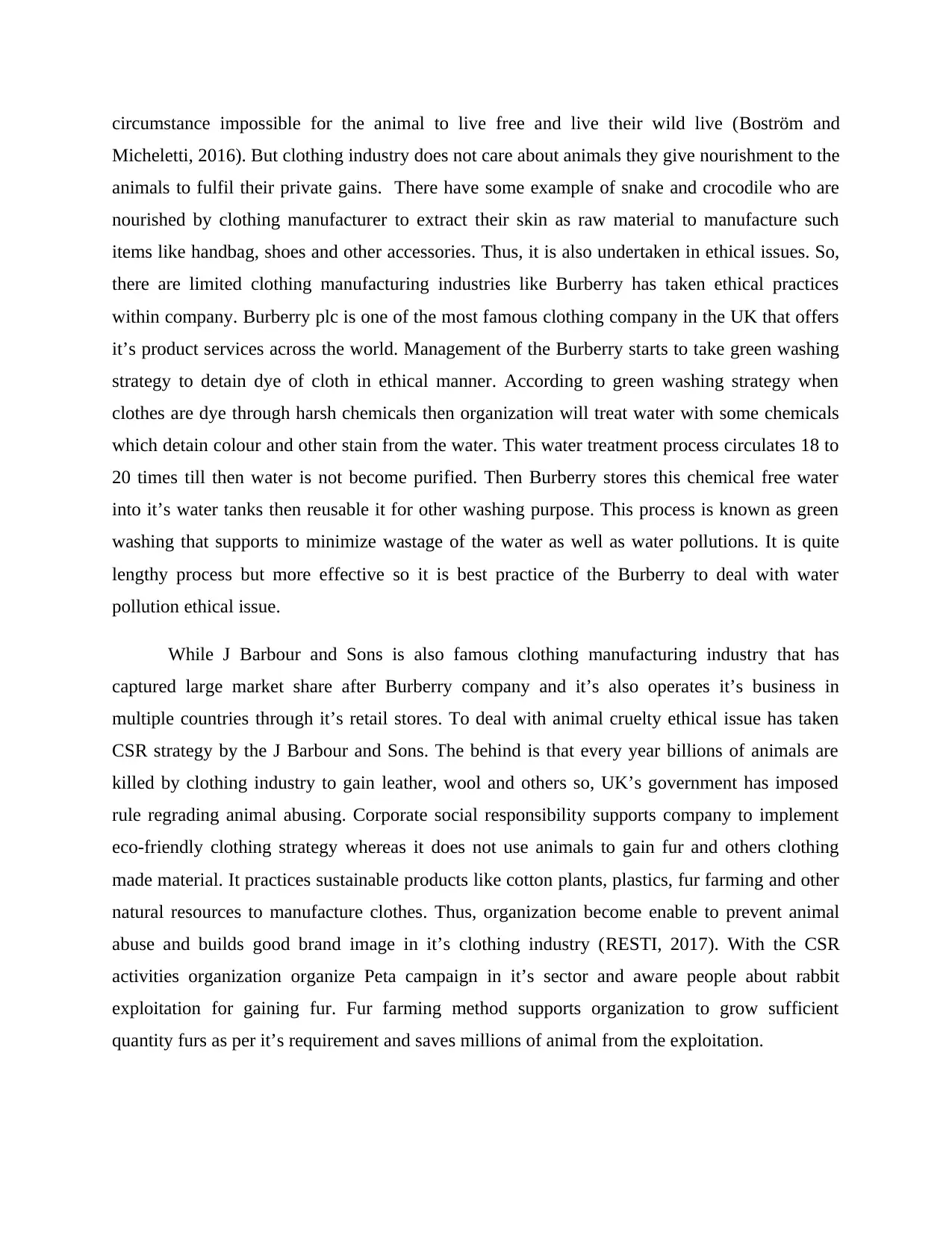
circumstance impossible for the animal to live free and live their wild live (Boström and
Micheletti, 2016). But clothing industry does not care about animals they give nourishment to the
animals to fulfil their private gains. There have some example of snake and crocodile who are
nourished by clothing manufacturer to extract their skin as raw material to manufacture such
items like handbag, shoes and other accessories. Thus, it is also undertaken in ethical issues. So,
there are limited clothing manufacturing industries like Burberry has taken ethical practices
within company. Burberry plc is one of the most famous clothing company in the UK that offers
it’s product services across the world. Management of the Burberry starts to take green washing
strategy to detain dye of cloth in ethical manner. According to green washing strategy when
clothes are dye through harsh chemicals then organization will treat water with some chemicals
which detain colour and other stain from the water. This water treatment process circulates 18 to
20 times till then water is not become purified. Then Burberry stores this chemical free water
into it’s water tanks then reusable it for other washing purpose. This process is known as green
washing that supports to minimize wastage of the water as well as water pollutions. It is quite
lengthy process but more effective so it is best practice of the Burberry to deal with water
pollution ethical issue.
While J Barbour and Sons is also famous clothing manufacturing industry that has
captured large market share after Burberry company and it’s also operates it’s business in
multiple countries through it’s retail stores. To deal with animal cruelty ethical issue has taken
CSR strategy by the J Barbour and Sons. The behind is that every year billions of animals are
killed by clothing industry to gain leather, wool and others so, UK’s government has imposed
rule regrading animal abusing. Corporate social responsibility supports company to implement
eco-friendly clothing strategy whereas it does not use animals to gain fur and others clothing
made material. It practices sustainable products like cotton plants, plastics, fur farming and other
natural resources to manufacture clothes. Thus, organization become enable to prevent animal
abuse and builds good brand image in it’s clothing industry (RESTI, 2017). With the CSR
activities organization organize Peta campaign in it’s sector and aware people about rabbit
exploitation for gaining fur. Fur farming method supports organization to grow sufficient
quantity furs as per it’s requirement and saves millions of animal from the exploitation.
Micheletti, 2016). But clothing industry does not care about animals they give nourishment to the
animals to fulfil their private gains. There have some example of snake and crocodile who are
nourished by clothing manufacturer to extract their skin as raw material to manufacture such
items like handbag, shoes and other accessories. Thus, it is also undertaken in ethical issues. So,
there are limited clothing manufacturing industries like Burberry has taken ethical practices
within company. Burberry plc is one of the most famous clothing company in the UK that offers
it’s product services across the world. Management of the Burberry starts to take green washing
strategy to detain dye of cloth in ethical manner. According to green washing strategy when
clothes are dye through harsh chemicals then organization will treat water with some chemicals
which detain colour and other stain from the water. This water treatment process circulates 18 to
20 times till then water is not become purified. Then Burberry stores this chemical free water
into it’s water tanks then reusable it for other washing purpose. This process is known as green
washing that supports to minimize wastage of the water as well as water pollutions. It is quite
lengthy process but more effective so it is best practice of the Burberry to deal with water
pollution ethical issue.
While J Barbour and Sons is also famous clothing manufacturing industry that has
captured large market share after Burberry company and it’s also operates it’s business in
multiple countries through it’s retail stores. To deal with animal cruelty ethical issue has taken
CSR strategy by the J Barbour and Sons. The behind is that every year billions of animals are
killed by clothing industry to gain leather, wool and others so, UK’s government has imposed
rule regrading animal abusing. Corporate social responsibility supports company to implement
eco-friendly clothing strategy whereas it does not use animals to gain fur and others clothing
made material. It practices sustainable products like cotton plants, plastics, fur farming and other
natural resources to manufacture clothes. Thus, organization become enable to prevent animal
abuse and builds good brand image in it’s clothing industry (RESTI, 2017). With the CSR
activities organization organize Peta campaign in it’s sector and aware people about rabbit
exploitation for gaining fur. Fur farming method supports organization to grow sufficient
quantity furs as per it’s requirement and saves millions of animal from the exploitation.
Paraphrase This Document
Need a fresh take? Get an instant paraphrase of this document with our AI Paraphraser
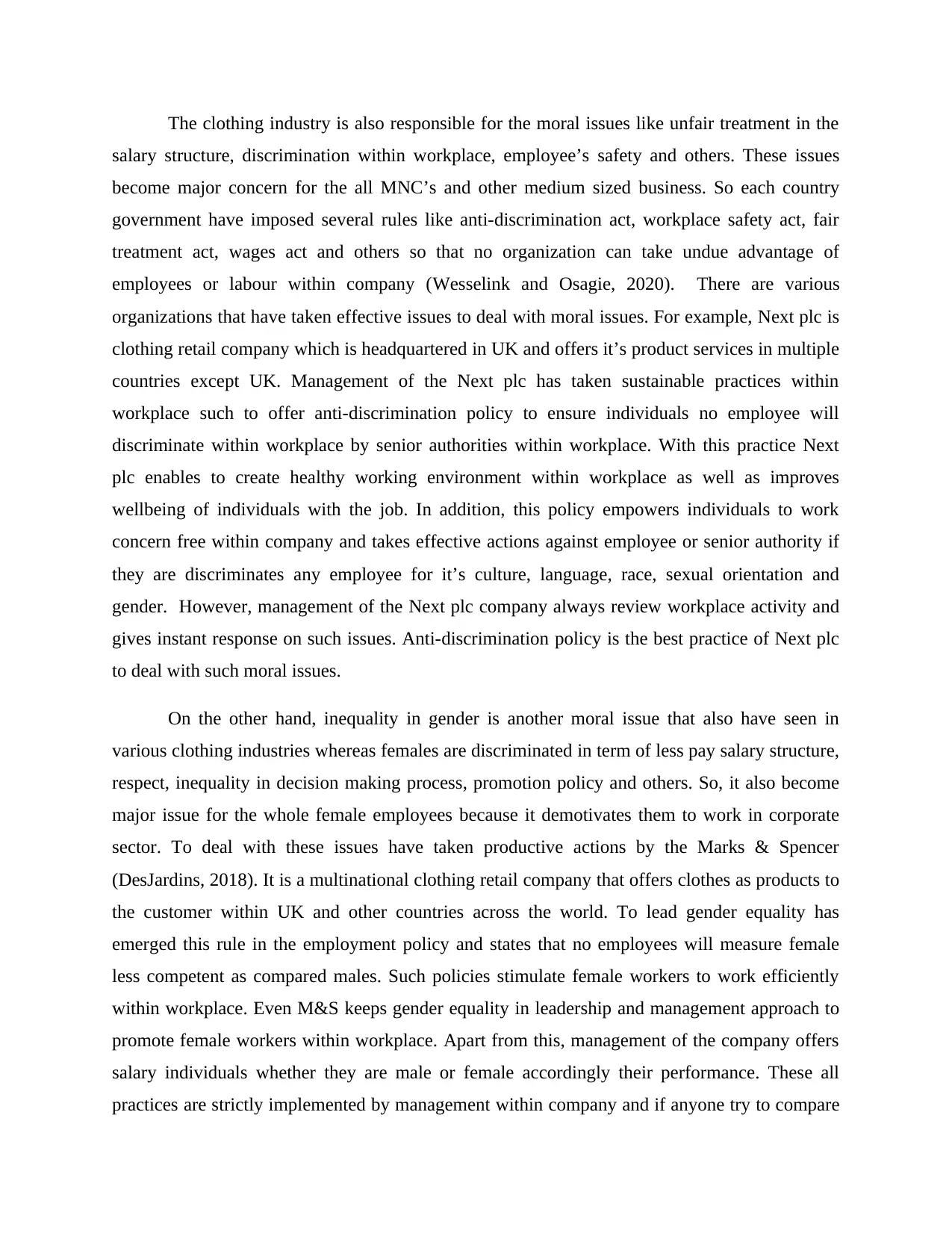
The clothing industry is also responsible for the moral issues like unfair treatment in the
salary structure, discrimination within workplace, employee’s safety and others. These issues
become major concern for the all MNC’s and other medium sized business. So each country
government have imposed several rules like anti-discrimination act, workplace safety act, fair
treatment act, wages act and others so that no organization can take undue advantage of
employees or labour within company (Wesselink and Osagie, 2020). There are various
organizations that have taken effective issues to deal with moral issues. For example, Next plc is
clothing retail company which is headquartered in UK and offers it’s product services in multiple
countries except UK. Management of the Next plc has taken sustainable practices within
workplace such to offer anti-discrimination policy to ensure individuals no employee will
discriminate within workplace by senior authorities within workplace. With this practice Next
plc enables to create healthy working environment within workplace as well as improves
wellbeing of individuals with the job. In addition, this policy empowers individuals to work
concern free within company and takes effective actions against employee or senior authority if
they are discriminates any employee for it’s culture, language, race, sexual orientation and
gender. However, management of the Next plc company always review workplace activity and
gives instant response on such issues. Anti-discrimination policy is the best practice of Next plc
to deal with such moral issues.
On the other hand, inequality in gender is another moral issue that also have seen in
various clothing industries whereas females are discriminated in term of less pay salary structure,
respect, inequality in decision making process, promotion policy and others. So, it also become
major issue for the whole female employees because it demotivates them to work in corporate
sector. To deal with these issues have taken productive actions by the Marks & Spencer
(DesJardins, 2018). It is a multinational clothing retail company that offers clothes as products to
the customer within UK and other countries across the world. To lead gender equality has
emerged this rule in the employment policy and states that no employees will measure female
less competent as compared males. Such policies stimulate female workers to work efficiently
within workplace. Even M&S keeps gender equality in leadership and management approach to
promote female workers within workplace. Apart from this, management of the company offers
salary individuals whether they are male or female accordingly their performance. These all
practices are strictly implemented by management within company and if anyone try to compare
salary structure, discrimination within workplace, employee’s safety and others. These issues
become major concern for the all MNC’s and other medium sized business. So each country
government have imposed several rules like anti-discrimination act, workplace safety act, fair
treatment act, wages act and others so that no organization can take undue advantage of
employees or labour within company (Wesselink and Osagie, 2020). There are various
organizations that have taken effective issues to deal with moral issues. For example, Next plc is
clothing retail company which is headquartered in UK and offers it’s product services in multiple
countries except UK. Management of the Next plc has taken sustainable practices within
workplace such to offer anti-discrimination policy to ensure individuals no employee will
discriminate within workplace by senior authorities within workplace. With this practice Next
plc enables to create healthy working environment within workplace as well as improves
wellbeing of individuals with the job. In addition, this policy empowers individuals to work
concern free within company and takes effective actions against employee or senior authority if
they are discriminates any employee for it’s culture, language, race, sexual orientation and
gender. However, management of the Next plc company always review workplace activity and
gives instant response on such issues. Anti-discrimination policy is the best practice of Next plc
to deal with such moral issues.
On the other hand, inequality in gender is another moral issue that also have seen in
various clothing industries whereas females are discriminated in term of less pay salary structure,
respect, inequality in decision making process, promotion policy and others. So, it also become
major issue for the whole female employees because it demotivates them to work in corporate
sector. To deal with these issues have taken productive actions by the Marks & Spencer
(DesJardins, 2018). It is a multinational clothing retail company that offers clothes as products to
the customer within UK and other countries across the world. To lead gender equality has
emerged this rule in the employment policy and states that no employees will measure female
less competent as compared males. Such policies stimulate female workers to work efficiently
within workplace. Even M&S keeps gender equality in leadership and management approach to
promote female workers within workplace. Apart from this, management of the company offers
salary individuals whether they are male or female accordingly their performance. These all
practices are strictly implemented by management within company and if anyone try to compare
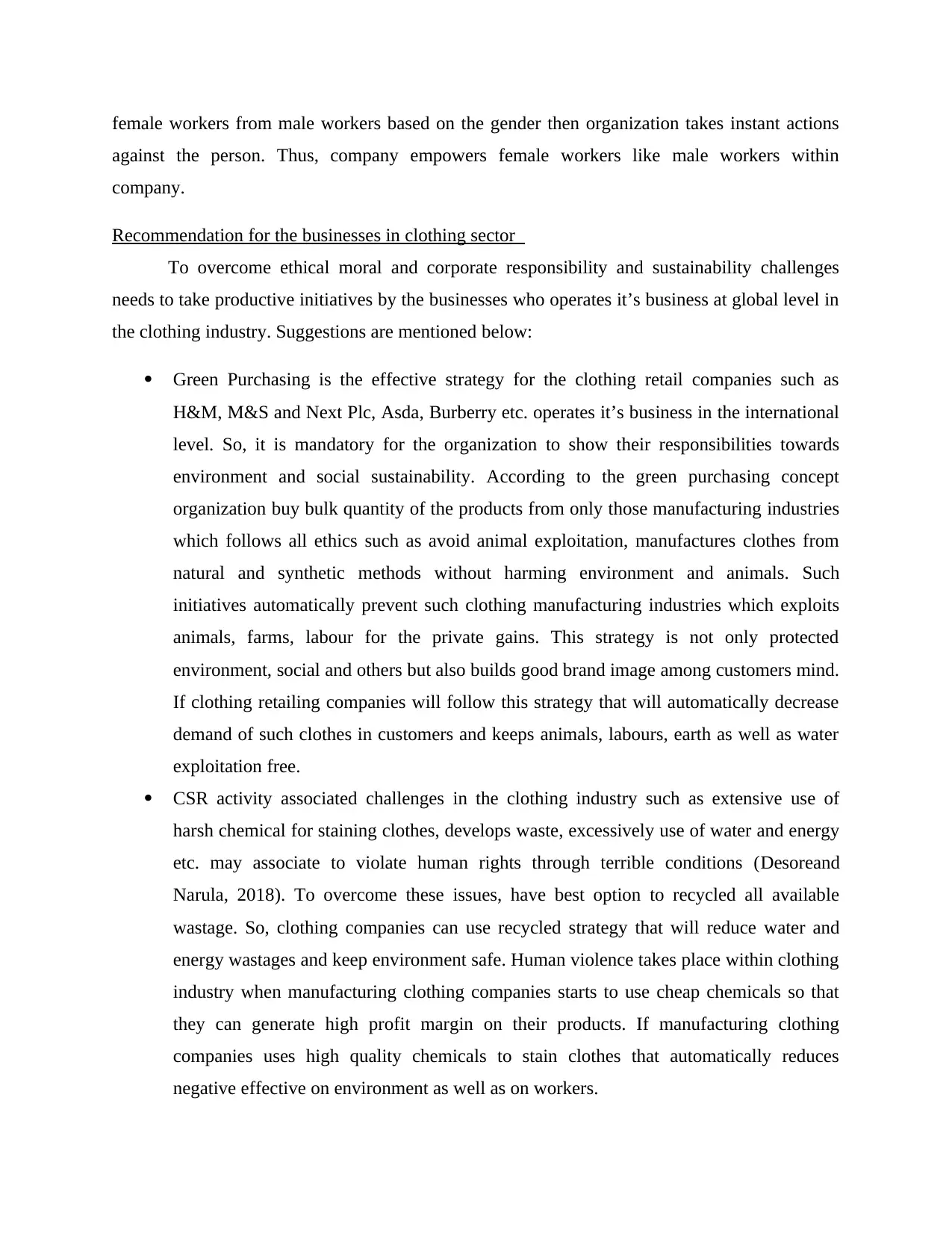
female workers from male workers based on the gender then organization takes instant actions
against the person. Thus, company empowers female workers like male workers within
company.
Recommendation for the businesses in clothing sector
To overcome ethical moral and corporate responsibility and sustainability challenges
needs to take productive initiatives by the businesses who operates it’s business at global level in
the clothing industry. Suggestions are mentioned below:
Green Purchasing is the effective strategy for the clothing retail companies such as
H&M, M&S and Next Plc, Asda, Burberry etc. operates it’s business in the international
level. So, it is mandatory for the organization to show their responsibilities towards
environment and social sustainability. According to the green purchasing concept
organization buy bulk quantity of the products from only those manufacturing industries
which follows all ethics such as avoid animal exploitation, manufactures clothes from
natural and synthetic methods without harming environment and animals. Such
initiatives automatically prevent such clothing manufacturing industries which exploits
animals, farms, labour for the private gains. This strategy is not only protected
environment, social and others but also builds good brand image among customers mind.
If clothing retailing companies will follow this strategy that will automatically decrease
demand of such clothes in customers and keeps animals, labours, earth as well as water
exploitation free.
CSR activity associated challenges in the clothing industry such as extensive use of
harsh chemical for staining clothes, develops waste, excessively use of water and energy
etc. may associate to violate human rights through terrible conditions (Desoreand
Narula, 2018). To overcome these issues, have best option to recycled all available
wastage. So, clothing companies can use recycled strategy that will reduce water and
energy wastages and keep environment safe. Human violence takes place within clothing
industry when manufacturing clothing companies starts to use cheap chemicals so that
they can generate high profit margin on their products. If manufacturing clothing
companies uses high quality chemicals to stain clothes that automatically reduces
negative effective on environment as well as on workers.
against the person. Thus, company empowers female workers like male workers within
company.
Recommendation for the businesses in clothing sector
To overcome ethical moral and corporate responsibility and sustainability challenges
needs to take productive initiatives by the businesses who operates it’s business at global level in
the clothing industry. Suggestions are mentioned below:
Green Purchasing is the effective strategy for the clothing retail companies such as
H&M, M&S and Next Plc, Asda, Burberry etc. operates it’s business in the international
level. So, it is mandatory for the organization to show their responsibilities towards
environment and social sustainability. According to the green purchasing concept
organization buy bulk quantity of the products from only those manufacturing industries
which follows all ethics such as avoid animal exploitation, manufactures clothes from
natural and synthetic methods without harming environment and animals. Such
initiatives automatically prevent such clothing manufacturing industries which exploits
animals, farms, labour for the private gains. This strategy is not only protected
environment, social and others but also builds good brand image among customers mind.
If clothing retailing companies will follow this strategy that will automatically decrease
demand of such clothes in customers and keeps animals, labours, earth as well as water
exploitation free.
CSR activity associated challenges in the clothing industry such as extensive use of
harsh chemical for staining clothes, develops waste, excessively use of water and energy
etc. may associate to violate human rights through terrible conditions (Desoreand
Narula, 2018). To overcome these issues, have best option to recycled all available
wastage. So, clothing companies can use recycled strategy that will reduce water and
energy wastages and keep environment safe. Human violence takes place within clothing
industry when manufacturing clothing companies starts to use cheap chemicals so that
they can generate high profit margin on their products. If manufacturing clothing
companies uses high quality chemicals to stain clothes that automatically reduces
negative effective on environment as well as on workers.
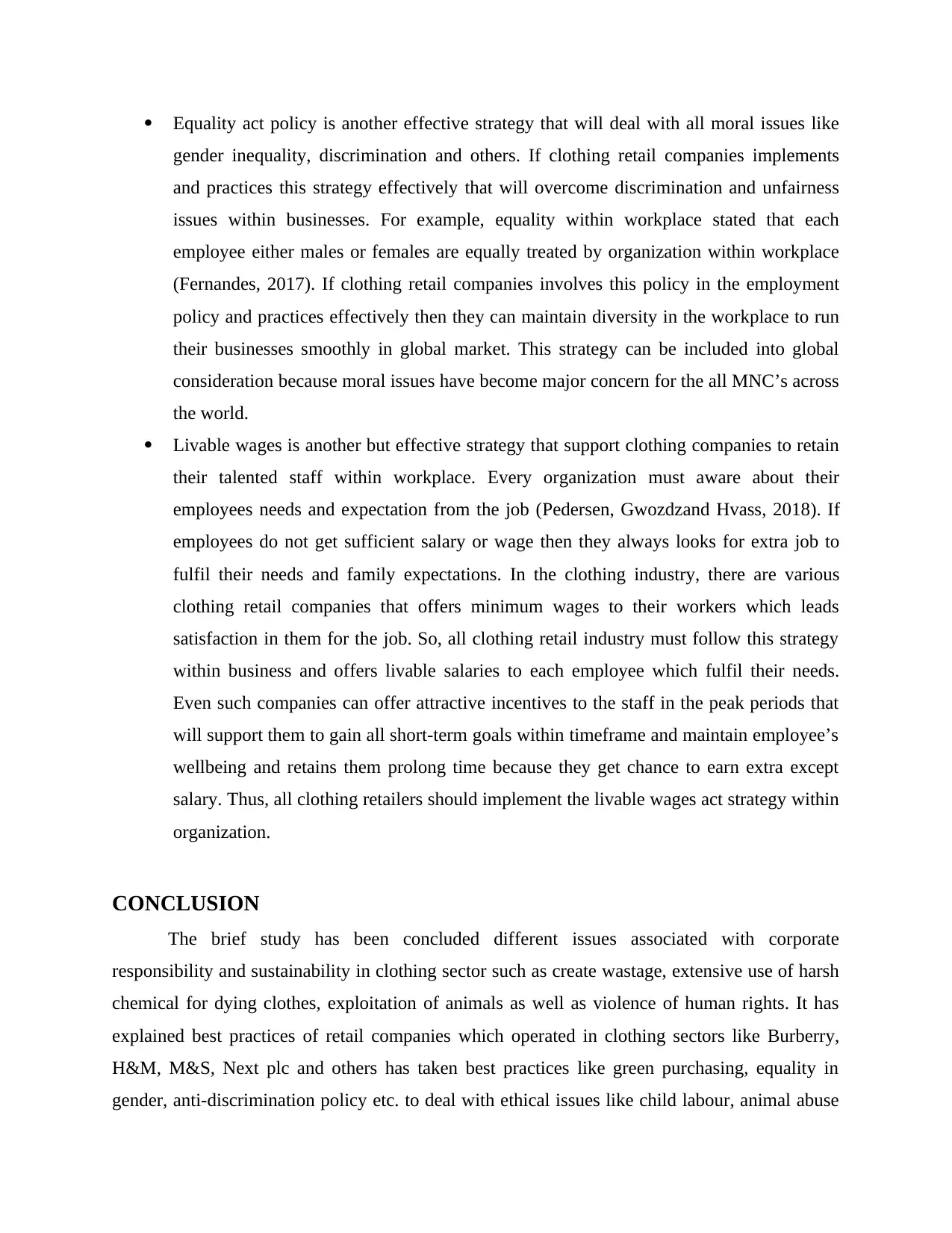
Equality act policy is another effective strategy that will deal with all moral issues like
gender inequality, discrimination and others. If clothing retail companies implements
and practices this strategy effectively that will overcome discrimination and unfairness
issues within businesses. For example, equality within workplace stated that each
employee either males or females are equally treated by organization within workplace
(Fernandes, 2017). If clothing retail companies involves this policy in the employment
policy and practices effectively then they can maintain diversity in the workplace to run
their businesses smoothly in global market. This strategy can be included into global
consideration because moral issues have become major concern for the all MNC’s across
the world.
Livable wages is another but effective strategy that support clothing companies to retain
their talented staff within workplace. Every organization must aware about their
employees needs and expectation from the job (Pedersen, Gwozdzand Hvass, 2018). If
employees do not get sufficient salary or wage then they always looks for extra job to
fulfil their needs and family expectations. In the clothing industry, there are various
clothing retail companies that offers minimum wages to their workers which leads
satisfaction in them for the job. So, all clothing retail industry must follow this strategy
within business and offers livable salaries to each employee which fulfil their needs.
Even such companies can offer attractive incentives to the staff in the peak periods that
will support them to gain all short-term goals within timeframe and maintain employee’s
wellbeing and retains them prolong time because they get chance to earn extra except
salary. Thus, all clothing retailers should implement the livable wages act strategy within
organization.
CONCLUSION
The brief study has been concluded different issues associated with corporate
responsibility and sustainability in clothing sector such as create wastage, extensive use of harsh
chemical for dying clothes, exploitation of animals as well as violence of human rights. It has
explained best practices of retail companies which operated in clothing sectors like Burberry,
H&M, M&S, Next plc and others has taken best practices like green purchasing, equality in
gender, anti-discrimination policy etc. to deal with ethical issues like child labour, animal abuse
gender inequality, discrimination and others. If clothing retail companies implements
and practices this strategy effectively that will overcome discrimination and unfairness
issues within businesses. For example, equality within workplace stated that each
employee either males or females are equally treated by organization within workplace
(Fernandes, 2017). If clothing retail companies involves this policy in the employment
policy and practices effectively then they can maintain diversity in the workplace to run
their businesses smoothly in global market. This strategy can be included into global
consideration because moral issues have become major concern for the all MNC’s across
the world.
Livable wages is another but effective strategy that support clothing companies to retain
their talented staff within workplace. Every organization must aware about their
employees needs and expectation from the job (Pedersen, Gwozdzand Hvass, 2018). If
employees do not get sufficient salary or wage then they always looks for extra job to
fulfil their needs and family expectations. In the clothing industry, there are various
clothing retail companies that offers minimum wages to their workers which leads
satisfaction in them for the job. So, all clothing retail industry must follow this strategy
within business and offers livable salaries to each employee which fulfil their needs.
Even such companies can offer attractive incentives to the staff in the peak periods that
will support them to gain all short-term goals within timeframe and maintain employee’s
wellbeing and retains them prolong time because they get chance to earn extra except
salary. Thus, all clothing retailers should implement the livable wages act strategy within
organization.
CONCLUSION
The brief study has been concluded different issues associated with corporate
responsibility and sustainability in clothing sector such as create wastage, extensive use of harsh
chemical for dying clothes, exploitation of animals as well as violence of human rights. It has
explained best practices of retail companies which operated in clothing sectors like Burberry,
H&M, M&S, Next plc and others has taken best practices like green purchasing, equality in
gender, anti-discrimination policy etc. to deal with ethical issues like child labour, animal abuse
Secure Best Marks with AI Grader
Need help grading? Try our AI Grader for instant feedback on your assignments.

and moral issues like unfair treatment, gender inequality, discrimination and others within
workplace in this report. then the brief study has summarized some suggestion for the companies
which operates in clothing industry and responsible for undertaking into global consideration in
the report.
workplace in this report. then the brief study has summarized some suggestion for the companies
which operates in clothing industry and responsible for undertaking into global consideration in
the report.
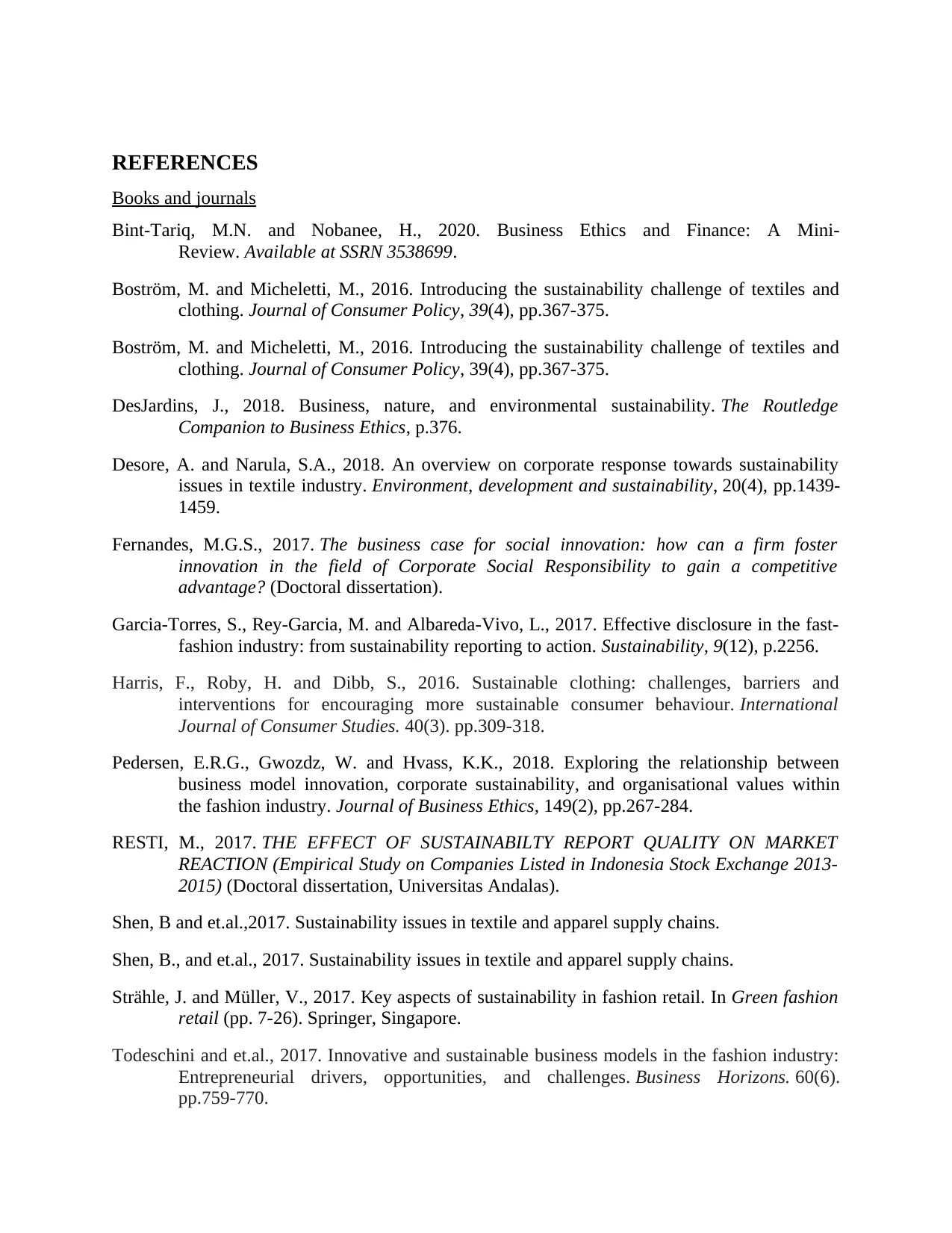
REFERENCES
Books and journals
Bint-Tariq, M.N. and Nobanee, H., 2020. Business Ethics and Finance: A Mini-
Review. Available at SSRN 3538699.
Boström, M. and Micheletti, M., 2016. Introducing the sustainability challenge of textiles and
clothing. Journal of Consumer Policy, 39(4), pp.367-375.
Boström, M. and Micheletti, M., 2016. Introducing the sustainability challenge of textiles and
clothing. Journal of Consumer Policy, 39(4), pp.367-375.
DesJardins, J., 2018. Business, nature, and environmental sustainability. The Routledge
Companion to Business Ethics, p.376.
Desore, A. and Narula, S.A., 2018. An overview on corporate response towards sustainability
issues in textile industry. Environment, development and sustainability, 20(4), pp.1439-
1459.
Fernandes, M.G.S., 2017. The business case for social innovation: how can a firm foster
innovation in the field of Corporate Social Responsibility to gain a competitive
advantage? (Doctoral dissertation).
Garcia-Torres, S., Rey-Garcia, M. and Albareda-Vivo, L., 2017. Effective disclosure in the fast-
fashion industry: from sustainability reporting to action. Sustainability, 9(12), p.2256.
Harris, F., Roby, H. and Dibb, S., 2016. Sustainable clothing: challenges, barriers and
interventions for encouraging more sustainable consumer behaviour. International
Journal of Consumer Studies. 40(3). pp.309-318.
Pedersen, E.R.G., Gwozdz, W. and Hvass, K.K., 2018. Exploring the relationship between
business model innovation, corporate sustainability, and organisational values within
the fashion industry. Journal of Business Ethics, 149(2), pp.267-284.
RESTI, M., 2017. THE EFFECT OF SUSTAINABILTY REPORT QUALITY ON MARKET
REACTION (Empirical Study on Companies Listed in Indonesia Stock Exchange 2013-
2015) (Doctoral dissertation, Universitas Andalas).
Shen, B and et.al.,2017. Sustainability issues in textile and apparel supply chains.
Shen, B., and et.al., 2017. Sustainability issues in textile and apparel supply chains.
Strähle, J. and Müller, V., 2017. Key aspects of sustainability in fashion retail. In Green fashion
retail (pp. 7-26). Springer, Singapore.
Todeschini and et.al., 2017. Innovative and sustainable business models in the fashion industry:
Entrepreneurial drivers, opportunities, and challenges. Business Horizons. 60(6).
pp.759-770.
Books and journals
Bint-Tariq, M.N. and Nobanee, H., 2020. Business Ethics and Finance: A Mini-
Review. Available at SSRN 3538699.
Boström, M. and Micheletti, M., 2016. Introducing the sustainability challenge of textiles and
clothing. Journal of Consumer Policy, 39(4), pp.367-375.
Boström, M. and Micheletti, M., 2016. Introducing the sustainability challenge of textiles and
clothing. Journal of Consumer Policy, 39(4), pp.367-375.
DesJardins, J., 2018. Business, nature, and environmental sustainability. The Routledge
Companion to Business Ethics, p.376.
Desore, A. and Narula, S.A., 2018. An overview on corporate response towards sustainability
issues in textile industry. Environment, development and sustainability, 20(4), pp.1439-
1459.
Fernandes, M.G.S., 2017. The business case for social innovation: how can a firm foster
innovation in the field of Corporate Social Responsibility to gain a competitive
advantage? (Doctoral dissertation).
Garcia-Torres, S., Rey-Garcia, M. and Albareda-Vivo, L., 2017. Effective disclosure in the fast-
fashion industry: from sustainability reporting to action. Sustainability, 9(12), p.2256.
Harris, F., Roby, H. and Dibb, S., 2016. Sustainable clothing: challenges, barriers and
interventions for encouraging more sustainable consumer behaviour. International
Journal of Consumer Studies. 40(3). pp.309-318.
Pedersen, E.R.G., Gwozdz, W. and Hvass, K.K., 2018. Exploring the relationship between
business model innovation, corporate sustainability, and organisational values within
the fashion industry. Journal of Business Ethics, 149(2), pp.267-284.
RESTI, M., 2017. THE EFFECT OF SUSTAINABILTY REPORT QUALITY ON MARKET
REACTION (Empirical Study on Companies Listed in Indonesia Stock Exchange 2013-
2015) (Doctoral dissertation, Universitas Andalas).
Shen, B and et.al.,2017. Sustainability issues in textile and apparel supply chains.
Shen, B., and et.al., 2017. Sustainability issues in textile and apparel supply chains.
Strähle, J. and Müller, V., 2017. Key aspects of sustainability in fashion retail. In Green fashion
retail (pp. 7-26). Springer, Singapore.
Todeschini and et.al., 2017. Innovative and sustainable business models in the fashion industry:
Entrepreneurial drivers, opportunities, and challenges. Business Horizons. 60(6).
pp.759-770.
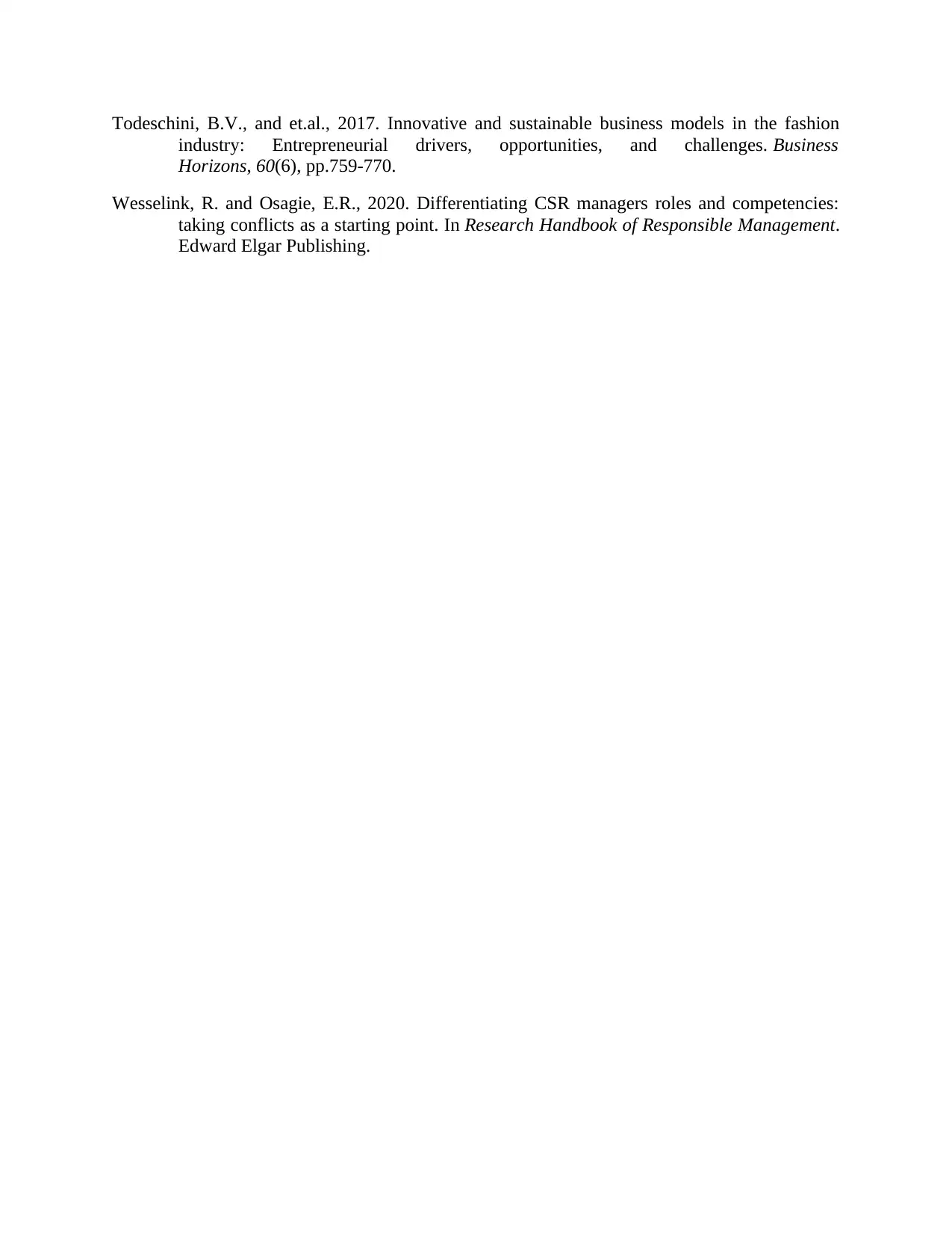
Todeschini, B.V., and et.al., 2017. Innovative and sustainable business models in the fashion
industry: Entrepreneurial drivers, opportunities, and challenges. Business
Horizons, 60(6), pp.759-770.
Wesselink, R. and Osagie, E.R., 2020. Differentiating CSR managers roles and competencies:
taking conflicts as a starting point. In Research Handbook of Responsible Management.
Edward Elgar Publishing.
industry: Entrepreneurial drivers, opportunities, and challenges. Business
Horizons, 60(6), pp.759-770.
Wesselink, R. and Osagie, E.R., 2020. Differentiating CSR managers roles and competencies:
taking conflicts as a starting point. In Research Handbook of Responsible Management.
Edward Elgar Publishing.
Paraphrase This Document
Need a fresh take? Get an instant paraphrase of this document with our AI Paraphraser

1 out of 14
Related Documents
Your All-in-One AI-Powered Toolkit for Academic Success.
+13062052269
info@desklib.com
Available 24*7 on WhatsApp / Email
![[object Object]](/_next/static/media/star-bottom.7253800d.svg)
Unlock your academic potential
© 2024 | Zucol Services PVT LTD | All rights reserved.





